|
Feb 2 - 5, 2007
Whanganui River Trip
We started our day by leaving Tongariro National Park early in the morning and heading off to the town of Piriaka to meet with our river outfitter. We had spent the night before making lists so we knew exactly what we needed when it came time to start filling the four 40-liter waterproof barrels we were provided. After filling out the necessary paperwork, we and our canoe were off to the put-in at Ohinepane.
We loaded everything on board, pushed off and immediately encountered our first "rapid". It was really just some big water, no rocks or anything to avoid but we did get quite wet right off the bat. The weather alternated between sunny and warm, and cloudy and cool, so at our lunch stop, we put on our waterproof pants which helped keep us warmer. The rest of the day was spent looking at the gorgeous scenery which included countless waterfalls, both large and small. The river level was low so the speed of the water was slow which made it easy to maneuver from river bank to river bank and even paddle back upstream to view something a second time. It was also a lovely experience to be on the river alone.
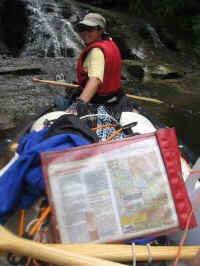
|
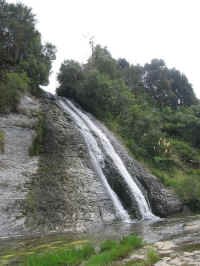
|
At the end of the day we stopped at our first DOC river campground (no road access available). Because the river can rise many feet very quickly, the campsites are up steep hillsides and all equipment must be carried up. After a long slog up, we found a very nice, large, flat site. There ended up only being three tents in the campground that night and we were able to use the provided shelter and cached rain water to cook our meals. It was a very pleasant and quiet night.
The next day we got up early because it was to be our longest paddling day on the river. The first, third and fourth days would only be 5-6 hours of paddling, but the second day had to be 8 hours in order to keep to our schedule for the take out on the last day. Starting early allowed us to still paddle at a leisurely pace, look at all of the gorgeous scenery and enjoy the beautiful weather. One stop was at the location of two Niu Poles that were erected by some Maori tribes during an inter-tribal war in the 1860's. One pole is the "War" pole calling on Maori from all points of the compass to come and join the fight. When peace was declared, a "Peace" pole was erected to off-set the power and spirits called by the original pole.
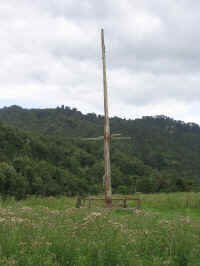
The Niu War Pole |
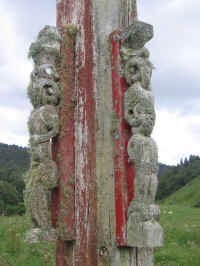
pole detail |
After a full day of once again being completely alone on the river, we arrived at John Coull Hut, another DOC provided shelter. We were greeted by the warden and told we were the only people there, so we could choose any campsite we wanted. We started up the steep hill and stopped at the first site we saw. It was small and a long way from the bathrooms and water, so we decided against it. We continued further up the hill and came out onto a terraced area nearer to the facilities. We decided to set up camp there. We then went for a swim in the river and watched as other canoeists started to arrive. First one or two canoes, then tour groups of canoes. With jaws dropped we watched as over the next hour or so, 25 other canoes arrived and sent up camp.
| There were tents side by side by side and we decided to rush back to the original site we had looked at to try to preserve some privacy and quiet. We were just in time as moments after we staked our claim to the spot, one of the tour guides tried to claim it and was gracious in ceding it for the night. It turned out to be a fine little spot with a clearing for a tent and a second clearing further along a path for a kitchen. We were even able to string up a tarp to protect us from the slight drizzle that started to fall. |
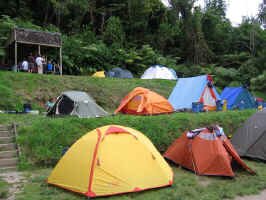
|
The next morning we took our time getting packed up and letting some of the other canoes get ahead of us on the river. We were able to spend part of our day in solitude, but occasionally we would catch up with someone who had taken a break or someone would overtake us. We all pretty much caught up with each other at a stop called "The Bridge to Nowhere". After World War I, the NZ government invited 48 families to open up an area near the river to development in exchange for free land. The area was poorly suited for farming, but the families gamely worked the land. The government undertook to build them roads and a bridge for access, but the area proved too difficult to maintain and as soon as the bridge was completed a big storm destroyed most of the access roads, and the government decided that they would no longer maintain the roads and the last of the struggling families were told to leave the area. The bridge now stands as a tourist attraction for boaters and hikers, a 40 minute hike deep into the Whanganui forest.
After we left the landing for the bridge hike, it started to rain. Sometimes a drizzle, sometimes a little harder. Fortunately we were equipped with waterproof clothing so it was not unpleasant paddling, just not as beautiful as the day before. Eventually we arrived at our evening's stop. Fortunately the groups had divided during the day and ended up staying at different campsites. At this site, there weren't quite as many campers, which was good because we all ended up trying to dodge the intermittent raindrops at the shelter and in the hut. Because of the rain, people were in the tents early and it was a quiet night.
| The campsite we chose was on the site of a Maori Marae. This Marae was different as the main house did not have any carvings on it, instead it had the Maori equivalent of a totem pole - very interesting! |
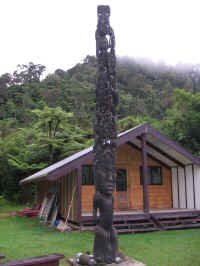
|
The morning of our last day dawned clear and we were on the river quickly. Our last day would bring three Class II rapids and we prepared by wearing our waterproof clothing. The first rapid came an hour into our paddle and turned out to be pretty insignificant, just some rapid water. Our second rapid came just before lunch and had more significant water. There were large "compression" waves squeezing between a rock wall and a sand bar. As we sped through the rapid, waves came over the bow and sides, rapidly filling us with water. Fortunately we were able to keep our balance and by bailing quickly were able to gain control of the canoe. We then pulled over to have lunch and watch other groups of canoes go through. Some were completely in control and others looked completely out of control, but no one lost their canoe. Everyone had to bail though and all were very wet.
Our last rapid also turned out to be insignificant and was only 100 meters from the take out. When we arrived our driver was already there to meet us and packing up was quickly accomplished. On the way back to where we had left the Fuso, we were treated to an ice cream which was a fitting end to our Whanganui adventure.
Getting back to the Blazing Paddles compound, we returned our rental equipment, cleaned up our gear and were back on the road in about an hour. We weren't planning to go far, just down the road to National Park. This isn't the Park, but rather a town about 6 miles from the park called National Park.
We found a free spot to park just outside the main backpacker hotel and went inside to do a quick bit of internet/email. Afterwards we headed next door to what turned out to be a great restaurant where we got a huge plate of bbq ribs. An excellent way to end the day.
|